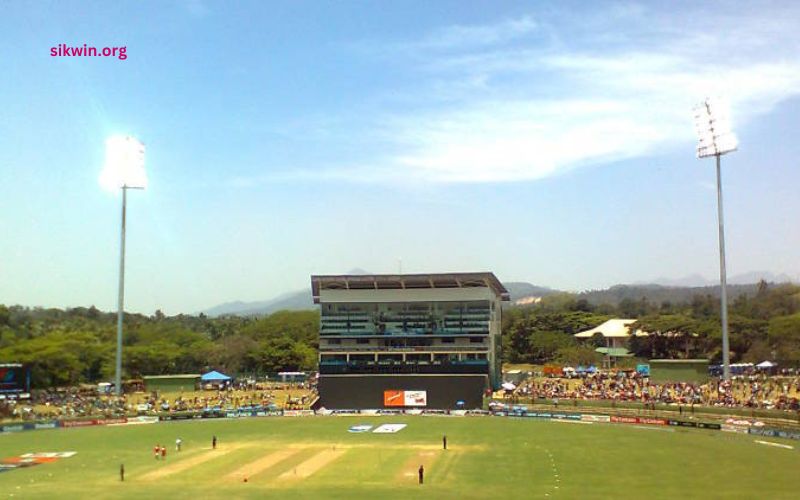Pallekele International Cricket Stadium, located in Kandy, Sri Lanka, is a premier venue that has hosted numerous international cricket matches since its establishment. Its picturesque setting against the backdrop of lush hills and the scenic Kandy region adds to the allure of the game played here. However, one of the most crucial factors influencing cricket matches at this stadium is the weather. In this article, we will delve into the weather patterns of Pallekele, their impact on cricket, and how teams adapt to these conditions.
Geographic and Climatic Overview
Location and Geography
Pallekele International Cricket Stadium is situated about 10 kilometers east of Kandy, nestled within the Central Province of Sri Lanka. The region is characterized by its hilly terrain and lush greenery, with the stadium itself being at an elevation of approximately 500 meters above sea level. This elevation contributes to a slightly cooler climate compared to the coastal regions of Sri Lanka.
Climate
Kandy, and by extension Pallekele, experiences a tropical rainforest climate. This means the area is warm and humid throughout the year, with significant rainfall even during the driest months. The average annual temperature hovers around 24-26°C (75-79°F), with minimal variation between the warmest and coolest months.
Seasonal Weather Patterns
Monsoon Seasons
Sri Lanka is influenced by two main monsoon seasons:
- Southwest Monsoon (May to September): This monsoon brings heavy rainfall to the southwestern parts of Sri Lanka but can also affect the Kandy region. During this period, Pallekele experiences frequent and intense rain showers, often leading to interruptions in cricket matches.
- Northeast Monsoon (December to February): The northeast monsoon affects the northeastern part of the island more directly, but Pallekele can still receive considerable rainfall. This season is generally less intense than the southwest monsoon but can still impact scheduling and play.
Inter-Monsoon Periods
The periods between the monsoons (March to April and October to November) are characterized by unpredictable weather patterns. These times can bring sudden thunderstorms and heavy downpours, complicating the planning of cricket fixtures.
Impact on Cricket
Match Interruptions and Delays
Rain is the most significant weather-related challenge at Pallekele. Matches frequently face interruptions due to sudden downpours. The stadium’s drainage system is efficient, but heavy rains can still lead to significant delays. The ground staff are adept at covering the pitch and outfield quickly, but persistent rain can result in reduced overs or even match abandonments.
Pitch Conditions
The weather profoundly affects the pitch conditions at Pallekele. During the wet season, the pitch tends to be softer and slower, providing assistance to spinners and making batting challenging. Conversely, during drier periods, the pitch can become harder and faster, offering more bounce and making it favorable for pace bowlers.
Dew Factor
Evening matches at Pallekele often have to contend with the dew factor, especially during the inter-monsoon and winter months. Dew makes the ball slippery, making it difficult for bowlers to grip and for fielders to handle. This usually benefits the batting side, as the ball skids more off the surface, making it easier to score runs.
Strategies for Teams
Batting Strategies
Teams often plan their batting strategies around the expected weather conditions. For instance, if rain is forecasted, the team winning the toss might opt to bowl first to take advantage of the DLS (Duckworth-Lewis-Stern) method later in the game. Additionally, batsmen aim to be aggressive in their approach to ensure they are ahead of the par score if rain interrupts play.
Bowling Strategies
Bowlers need to adapt to the changing conditions at Pallekele. During wet conditions, spinners come into play more, while fast bowlers focus on variations and cutters rather than outright pace. Conversely, during dry spells, fast bowlers can extract more bounce and carry, making life difficult for the batsmen.
Fielding Adjustments
Fielding teams need to be prepared for slippery conditions due to dew or rain. This often means positioning fielders more conservatively to prevent boundaries and focusing on quick singles rather than attempting risky catches. The choice of footwear also becomes crucial, with players opting for longer spikes to maintain stability on the wet outfield.
Memorable Matches Affected by Weather
ICC World Twenty20 2012
One of the notable instances of weather affecting a match at Pallekele was during the ICC World Twenty20 in 2012. Rain interrupted several matches, leading to the application of the DLS method. For instance, the Super Eight match between England and New Zealand saw rain interruptions, but despite this, New Zealand managed to clinch a narrow win in a rain-shortened game.
Sri Lanka vs. Australia, 2016
During Australia’s tour of Sri Lanka in 2016, the second ODI at Pallekele was significantly affected by rain. The match was reduced to 47 overs per side. Despite the interruptions, Sri Lanka managed to post a formidable total and secured a victory, demonstrating their ability to adapt to the challenging conditions.
Technological and Infrastructural Adaptations
Advanced Drainage Systems
Pallekele International Cricket Stadium is equipped with a state-of-the-art drainage system designed to cope with heavy rainfall. This system allows the ground to dry quickly and matches to resume sooner than they might at other venues with less sophisticated infrastructure.
Use of Covers
The ground staff at Pallekele are highly efficient in covering the pitch and the outfield. Large, motorized covers are used to protect the playing area from rain. This ensures that the pitch remains dry and playable even after a heavy downpour.
Weather Forecasting
Modern weather forecasting tools are employed to predict rain and other weather conditions accurately. Teams and officials rely on these forecasts to make informed decisions about playing conditions and match timings. This includes radar technology that can predict rain intensity and duration, allowing for better preparation and less disruption.
Conclusion
The weather at Pallekele International Cricket Stadium is a dynamic and influential factor in cricket matches. From the monsoon rains to the evening dew, various elements impact how the game is played and managed. Teams must be adaptable and strategic to succeed in these conditions, leveraging local knowledge and modern technology to gain an edge.
Despite the challenges posed by weather, Pallekele remains a beloved venue for cricket, known for its beautiful setting and passionate crowd. The stadium’s ability to handle weather-related disruptions and continue to host high-quality cricket is a testament to the dedication of its staff and the resilience of the sport itself.
Understanding the weather patterns at Pallekele is not just about predicting rain delays but about appreciating the intricate ways in which nature influences the game of cricket. Whether it’s the way the pitch behaves after a downpour or how teams adjust their strategies to cope with dew, the weather at Pallekele adds a unique and fascinating dimension to the cricketing experience.




